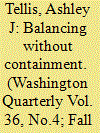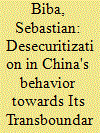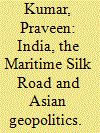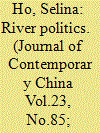|
|
|
Sort Order |
|
|
|
Items / Page
|
|
|
|
|
|
|
| Srl | Item |
| 1 |
ID:
126866


|
|
|
| 2 |
ID:
127771


|
|
|
|
|
| Publication |
2014.
|
| Summary/Abstract |
Fresh water has no substitute, and its availability has been declining sharply around the globe. In Asia, China's role as a multidirectional and transborder water provider is unmatched. Analysis of China's behavior towards its transboundary rivers is therefore pivotal. By examining three different case studies-the Mekong River in Southeast Asia, the Brahmaputra River in South Asia and the Irtysh and Ili Rivers in Central Asia-this article seeks to lay the theoretical groundwork for understanding China's behavior. It pits previously applied realist rationales against the more recent notion of desecuritization strategies and makes a case for the latter. While desecuritization implies non- or de-escalation, it does not necessarily mean genuine long-term cooperation. The future of Asia's shared waters may thus be a contentious one.
|
|
|
|
|
|
|
|
|
|
|
|
|
|
|
|
| 3 |
ID:
147985


|
|
|
|
|
| Summary/Abstract |
Paul Kennedy, the author of The Rise and Fall of the Great Powers in one of his later works, entitled Preparing for the Twenty-First Century has argued that India and China can potentially do harm to themselves and the planet, given their rising population and limited resources. He has urged upon the developed world to “apply its capital, technology and brainpower to help them.” While there may be limitations to this argument, first being a western perspective and then on considerations such as with regards to the extent to which the developed world intends helping India and China, and to what extent India and China are willing to accept the terms, if any, of that help, but one thing that the author has highlighted is of significance. This pertains to the likely ‘conflict of interests’ over common resources and market between the two countries.
|
|
|
|
|
|
|
|
|
|
|
|
|
|
|
|
| 4 |
ID:
167169


|
|
|
|
|
| Summary/Abstract |
The Belt and Road Initiative (BRI), formerly known as One Belt One Road (OBOR), has emerged as one of the top priorities for Chinese President Xi Jinping ever since he unveiled the initiative in 2013. This special issue surveys the reception of BRI in East Asia. As China’s immediate neighborhood, this region will play an important role in determining whether Beijing’s signature project will succeed in the mid- to long term. However, research has thus far mostly focused on BRI’s reception in Central Asia and (Eastern) Europe. In this introduction, we first provide an overview of the literature by identifying three main strands of interpretation on BRI, namely those focusing on geoeconomics, on geopolitics, and on international norms as well as order. Next, we provide a review of the contemporary research on both Southeast Asian and Northeast Asian perceptions of and policy responses to BRI. Finally, we discuss research gaps in the literature and provide an overview of case studies and findings in this special issue. We conclude by identifying recurring themes and characteristics in East Asian responses to BRI.
|
|
|
|
|
|
|
|
|
|
|
|
|
|
|
|
| 5 |
ID:
123439


|
|
|
|
|
| Publication |
2013.
|
| Summary/Abstract |
This article calls for an expansion in the study of Asian geopolitics beyond the Indo-Pacific axis. China's geostrategic rise and that of Asia's other main powers are phenomena that bear multiple maritime and continental manifestations. Insofar as Asia's powers meet in different regions, the "primary" Indo-Pacific theater cannot be isolated from developments in Central, South, Southeast, Northeast Asia, the northwestern Pacific, or the Arctic. By conceptualizing seapower and landpower as an interactive dyad in geostrategy and zooming in on the maritime and continental directions of China, India, and Russia, this article depicts Asia as an increasingly interdependent geopolitical whole.
|
|
|
|
|
|
|
|
|
|
|
|
|
|
|
|
| 6 |
ID:
127770


|
|
|
|
|
| Publication |
2014.
|
| Summary/Abstract |
China manages its transboundary rivers as a subset of its broader relations with other riparian states. This results in discernible differences in the way China approaches its international river systems. Although there is a limit to the extent of Chinese cooperation, in relative terms China is more cooperative in the Mekong than in the Brahmaputra. To China, Southeast Asian states are part of a hierarchical system where it stands at the apex. While problems exist, there are deep linkages between them, which help foster collaboration in the Mekong. India, which has greater power parity with China, is not part of China's hierarchical worldview. The territorial disputes and security dilemmas that characterize South Asian geopolitics further impede cooperation. Domestic considerations also impact on China's river policies. There is greater consensus among Chinese policymakers in managing the Mekong than the Brahmaputra, which explains the higher degree of clarity in Chinese policies towards the former compared to the latter.
|
|
|
|
|
|
|
|
|
|
|
|
|
|
|
|
|
|
|
|
|